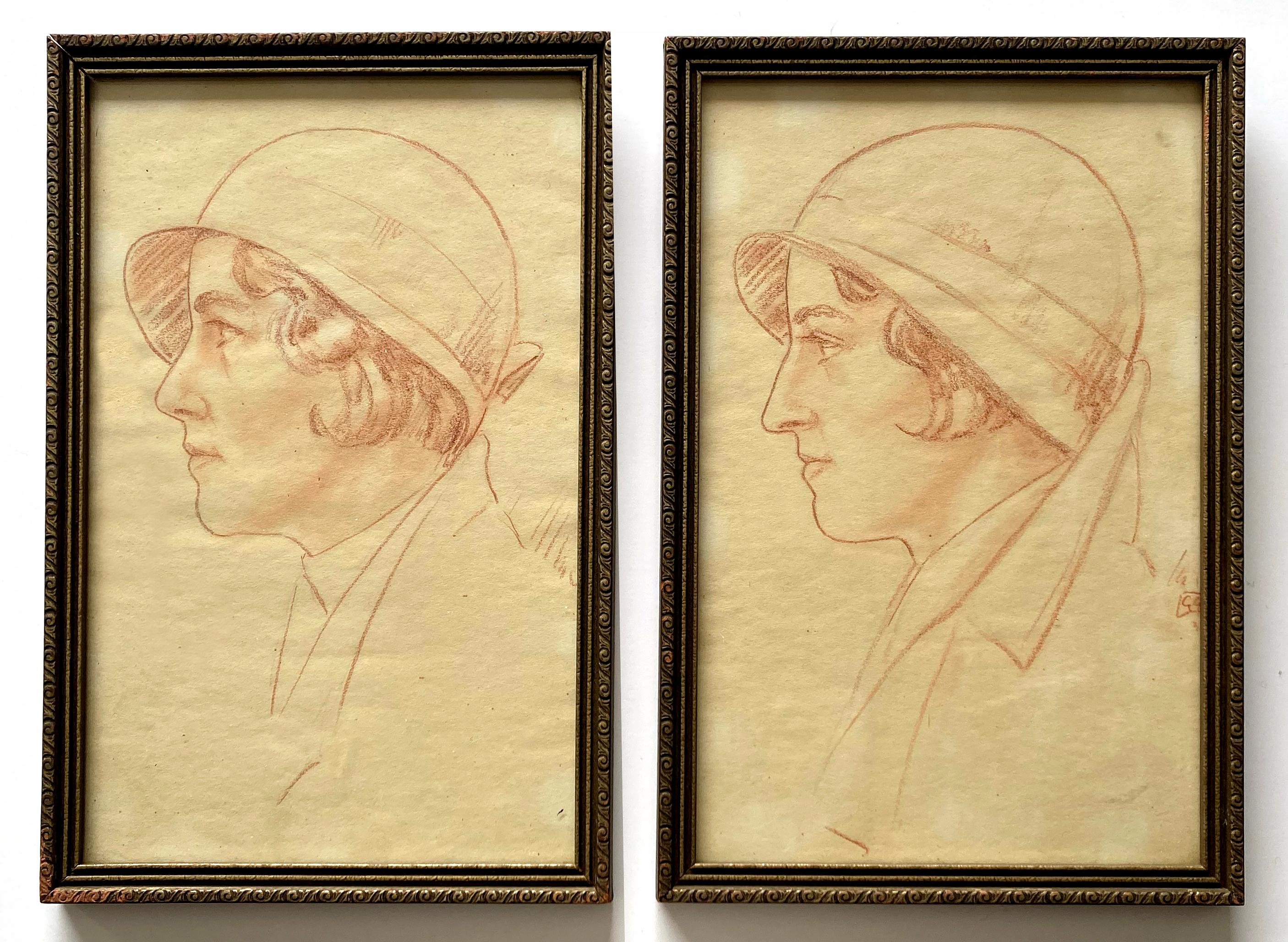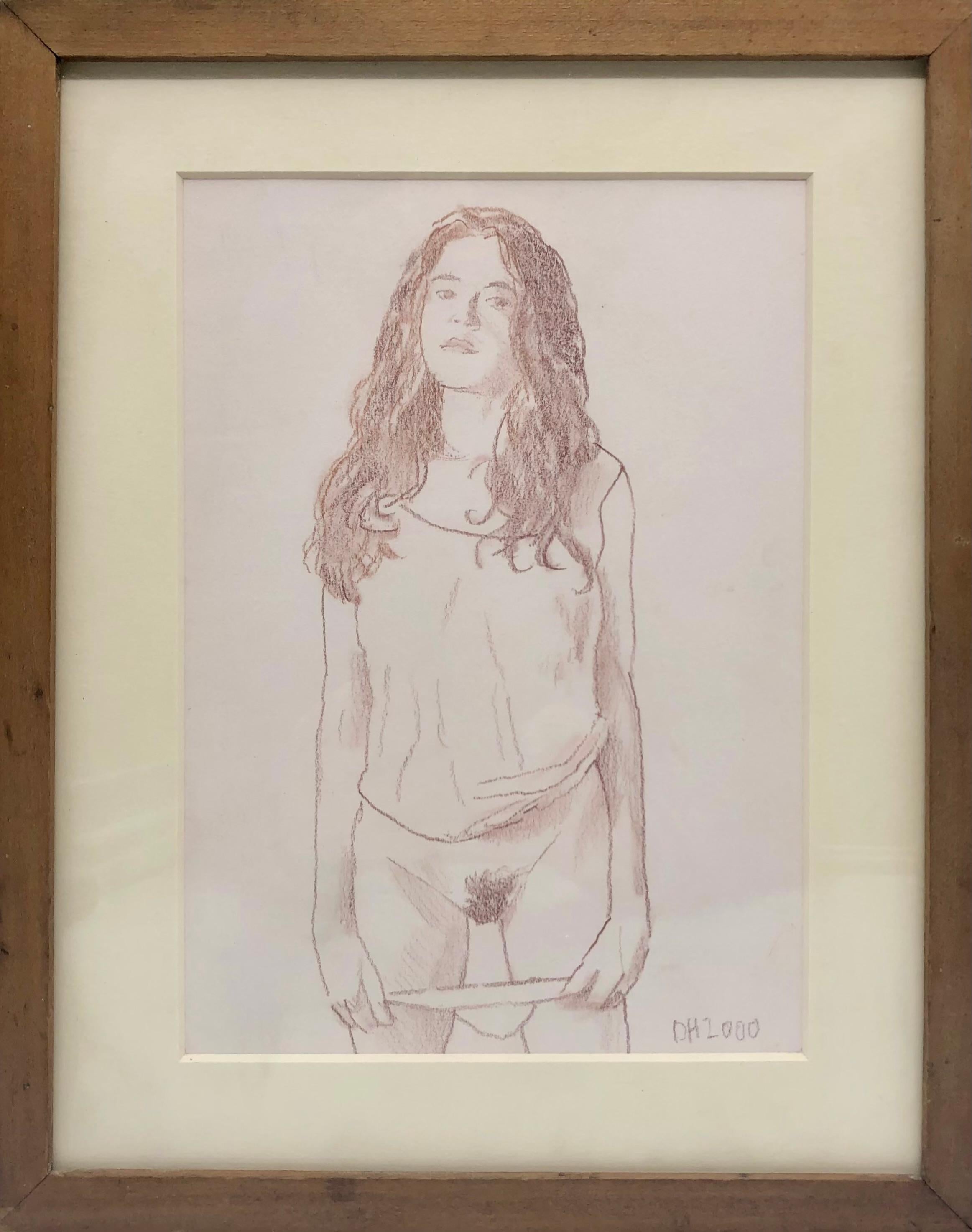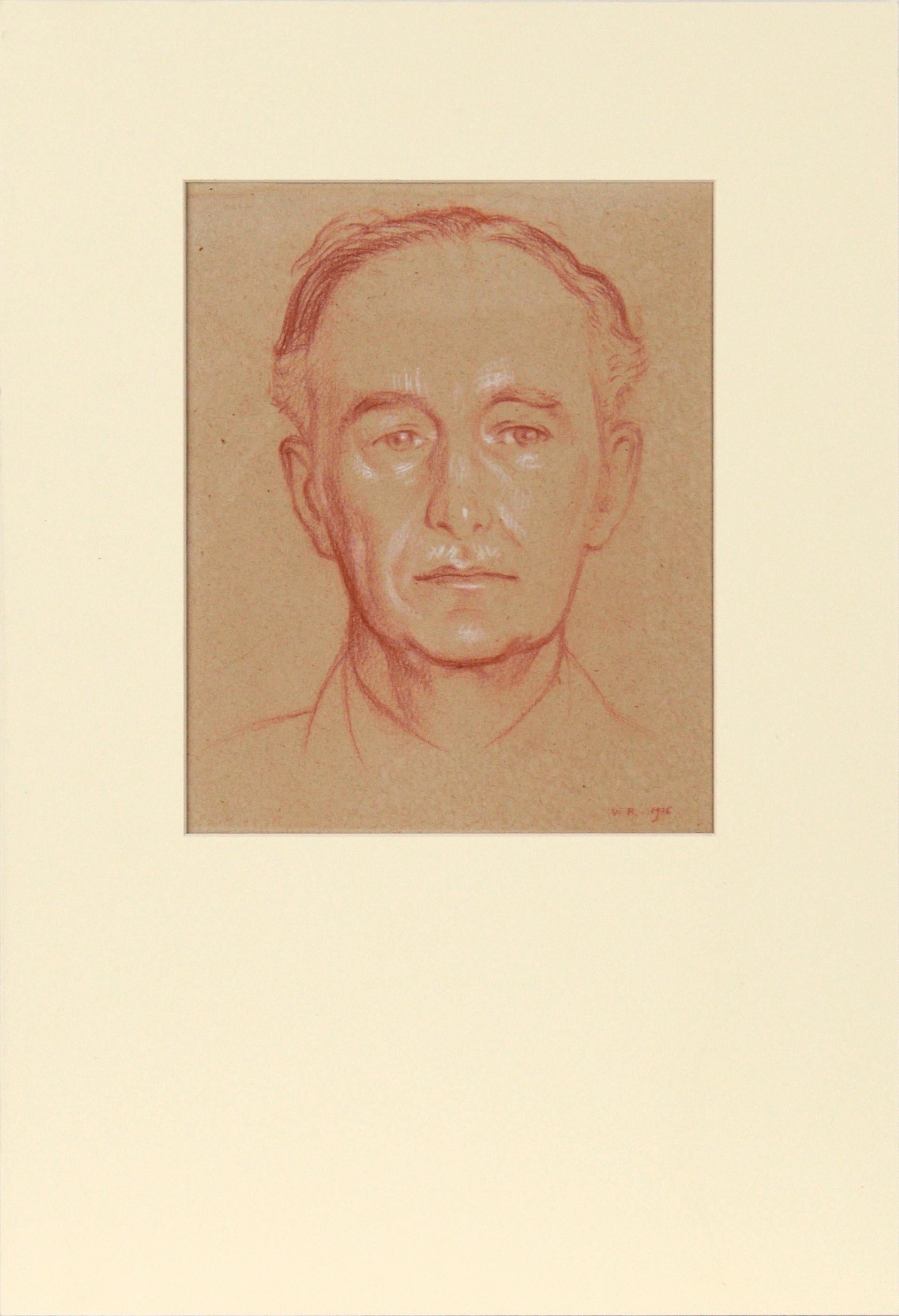Items Similar to Head Study, 1930
Want more images or videos?
Request additional images or videos from the seller
1 of 4
John SloanHead Study, 19301930
1930
About the Item
Head Study, 1930
John Sloan (1871-1951)
Signed Lower Right
10.5" x 9" Unframed
19" x 16.5" Framed
Born in Lock Haven, Pennsylvania, John Sloan became one of the major early 20th- century figures in New York, pioneering the Social Realist movement with Robert Henri and his circle. He was also an illustrator and early eastern painter in the Southwest.
Sloan moved with his family to Philadelphia where he attended Central High School and became a close friend of William Glackens. He worked for a print dealer and as illustrator for the Philadelphia Inquirer and the Philadelphia Press. He also studied at the Pennsylvania Academy with Thomas Anshutz and met Robert Henri.
In 1904, he moved to New York and while continuing as an illustrator, became a part of Henri's circle of urban realists. He was an avid walker who continually strolled the streets for subject matter, especially exploring Greenwich Village and the Lower East Side. His work with great humanitarian bent flourished especially during this time because he was so committed emotionally to his subject matter.
He joined the Socialist Party in 1910 and espoused utopian ideas of equality but was never a political activist. However, from 1912 to 1916, he was art editor of the party's monthly periodical The Masses, and his skillful illustrations elevated the quality of the publication. The realities of World War I caused him, like so many, to become disenchanted with hard-line socialism.
He taught at the Art Students League, and his students included Reginald Marsh, Raphael Soyer, and Alexander Calder.
Opposing the traditional hold that the National Academy had over the art world in America, he exhibited as one of "The Eight" in 1908 at the Macbeth Gallery. In 1913, he was much affected by the Armory Show exhibition of modernist painting, particularly the Post-Impressionist, Fauve, and Cubist works and after that year became experimenting with more radical painting styles. He was also an avid etcher.
Influenced by his friend Henri, who had spent summers of 1916 and 1917 in New Mexico, Sloan and his wife Dolly first visited Santa Fe in 1919. From that time, he made several painting trips to the Southwest and was active in the Santa Fe colony and in getting other eastern artists to head West. Unlike many of his contemporaries there, he refused to paint romanticized views of the Mexican and Indian culture. He served as President of the Exposition of Indian Tribal Arts in the 1930s and lobbied the Society of Independent Artists to include work by Native Americans in their exhibitions.
In 1944, Sloan married Helen Farr, who had been one of his students, and after her husband's death in 1951, she devoted herself to turning his estate into a philanthropic instrument. The largest benefactor was the Delaware Art Museum, which received more than 5000 works including painting representing every phase of his career and his archival papers. With these acquisitions, the Museum became the leading repository for the study of Sloan. In honor of the ongoing support by Helen Farr Sloan, museum representatives named its library the Helen Farr Sloan Library.
- Creator:John Sloan (1832-1932, American)
- Creation Year:1930
- Dimensions:Height: 10.5 in (26.67 cm)Width: 9 in (22.86 cm)
- Medium:
- Movement & Style:
- Period:
- Condition:
- Gallery Location:Missouri, MO
- Reference Number:1stDibs: LU747310870882
About the Seller
5.0
Vetted Seller
These experienced sellers undergo a comprehensive evaluation by our team of in-house experts.
Established in 1970
1stDibs seller since 2017
141 sales on 1stDibs
Typical response time: 21 hours
- ShippingRetrieving quote...Ships From: Missouri, MO
- Return PolicyA return for this item may be initiated within 2 days of delivery.
More From This SellerView All
- Self-PortraitBy Sean KeatingLocated in Missouri, MOSean Keating (Irish 1889-1977) "Self Portrait" c. 1950s Charcoal on Paper Signed Lower Right Framed Size: approx 20 x 16 inches A noted portrait and figure painter, influenced by b...Category
1950s Realist Figurative Drawings and Watercolors
MaterialsCharcoal, Archival Paper
- Golf Bags, Caddy with Golf Bag on His BackBy Frederick ConwayLocated in Missouri, MOFramed Size: approx 17 3/4 x 20 3/4 inches Fred Conway (1900-1973) "Golf Bags, Caddy with Golf Bag on His Back" Pen/Ink/Watercolor on Paper Site Size: approx. 10 x 13 inches Framed Size: approx. 17 3/4 x 20 3/4 inches A member of the faculty of the Washington University Art School from 1929 to 1970, Frederick Conway...Category
1960s American Modern Figurative Drawings and Watercolors
MaterialsPaper, Ink, Watercolor, Pen
- Medicine ManBy Cassilly AdamsLocated in Missouri, MOCassilly Adams (American 1843-1921) "Medicine Man" c. 1860s Watercolor on Paper Unsigned Provenance: Questroyal Gallery, NYC Site Size: approx. 14.5 x 8....Category
Mid-19th Century American Realist Figurative Drawings and Watercolors
MaterialsPaper, Watercolor
- The Village MarketBy Jacob EisenscherLocated in Missouri, MOJacob (Yaacov) Eisenscher "The Village Market" 1947 Gouache/Watercolor on Paper Signed and Dated Lower Left Image Size: approx 18 x 12.5 Framed Size: approx 27 1/8 x 22 1/4 inches ...Category
1940s Realist Figurative Drawings and Watercolors
MaterialsPaper, Gouache
- An Opulent EveningBy Guiseppe AureliLocated in Missouri, MOGuiseppe Aureli (1858-1929) "An Opulent Evening" c. 1880s Watercolor on Paper Signed Lower Right Site Size: approx. 30 x 20 inches Framed Size: approx. 37 x 29 inches Giuseppe Aureli (December 5, 1858 in Rome – 1929) was an Italian painter and watercolorist. His work is noted for its historical subject matter, portraits of Italian noble families as well as genre paintings and local scenes, especially work with Oriental themes. He received his early art education at the Academia de San Luca where he was the pupil of Pietro Gabarini and Cesare Maccari.[1] He exhibited in various exhibitions; including: The International Exhibition of 1888 in Munich and the World Fair of 1893 in Chicago, but his Oriental works were rarely included in these early exhibitions. Having his workshop at 48 Via Margutta in Rome, Aureli was in a position to exchange ideas with the most prolific Orientalist artists at that the time. He used the same staircase that led to a rabbit-warren of studios including those of Filippo Bartolini, Enrico Tarenghi...Category
Late 19th Century Victorian Figurative Drawings and Watercolors
MaterialsWatercolor, Laid Paper
- A Close CompetitionBy Maurice MilliereLocated in Missouri, MOMaurice Milliere (1871-1946) "A Close Competition" 1905 Colored Pencil on Paper Signed and Dated Lower Left Site: approx. 35 x 36 inches Framed: approx. 43 x 35 inches Born at Le Havre in Normandy on 12th December 1871, Millière began his art education in his home town but soon transferred to l'Ecole des Beaux-Arts in Paris, where he studied portraiture, life drawing and figure painting in the atelier of Leon Bonnat, whose pupils included Toulouse-Lautrec and Raoul Dufy. He also studied at l'Ecole des Arts Decoratifs. His skill as a draughtsman translated quickly into success as a cartoonist and illustrator and his brilliant interpretation of the "Modern Parisienne" soon became known as the "Petite femme...Category
Early 1900s Art Nouveau Figurative Drawings and Watercolors
MaterialsPaper, Color Pencil
You May Also Like
- Pair of antique portraits women period clothes framed drawing red hats 19thLocated in Buffalo, NYA pair of original red conte crayon drawings in their original frames featuring two young women in period clothing.Category
1910s Art Deco Portrait Drawings and Watercolors
MaterialsPaper, Conté
- "Regarding Agnes" - Portrait of a Young Woman, DrawingBy Duncan HannahLocated in East Quogue, NYPortrait of a semi-attired young woman titled "Regarding Agnes" by Duncan Hannah. Conte pencil on paper. Signed front lower right. Offered framed. Frame size: 10.75 x 8.75 inches ...Category
Early 2000s American Realist Figurative Drawings and Watercolors
MaterialsConté, Paper
- "Self Portrait Conte Sketch" rare Ben Fenske work on paper - academic studyBy Ben FenskeLocated in Sag Harbor, NYA colorful self-portrait from Ben Fenske, staring at the viewer straight-on. Hues of red dominate. Unframed. Ben Fenske (b. 1978) although a native of Minnesota, and has been worki...Category
Early 2000s Academic Portrait Drawings and Watercolors
MaterialsPaper, Conté
- Self Portrait SketchBy Ben FenskeLocated in Sag Harbor, NYAn early work on paper, by American Impressionist painter, Ben Fenske. It's rare to see a drawing like this from Fenske, especially of a self portrait. Fenske uses classical draftin...Category
Early 2000s Academic Portrait Drawings and Watercolors
MaterialsPaper, Conté
- Portrait of George Arliss in Conte Crayon on Cardstock 1934Located in Soquel, CAStately portrait of George Arliss by Ivan Opffer (Danish, 1897-1980). Mr. Arliss is depicted wearing his signature monocle, looking directly at the viewer. Although this piece appears to be done rapidly, there is a clear confidence in Opffer's work - he was an accomplished portrait artist - and the resemblance to the subject is unmistakable. George Arliss (born Augustus George Andrews; 10 April 1868 – 5 February 1946) was an English actor, author, playwright, and filmmaker who found success in the United States. He was the first British actor to win an Academy Award – which he won for his performance as Victorian-era British prime minister Benjamin Disraeli in Disraeli (1929) – as well as the earliest-born actor to win the honour. He specialized in successful biopics, such as Disraeli, Voltaire (1933), and Cardinal Richelieu (1935), as well as light comedies, which included The Millionaire (1931) and A Successful Calamity (1932). Signed and dated "Ivan Opffer 1934" in the lower right. Titled "Mr. Arliss" in the lower left. Presented in a new off-white mat with foamcore backing. Mat size: 22"H x 16"W Art size: 17.5"H x 12"W Ivan Opffer (Danish, 1897-1980) was born in Nyborg, Denmark, on June 4, 1897, to a family of Danish scholars and journalists. His brother was Emil Opffer, a Danish merchant seaman and journalist who was known for his relationship with American writer Hart Crane. Ivan was raised in Mexico City and New York, where his anarchist father was the editor of a radical Danish-language newspaper. His involvement in painting and drawing began at an early age. At a summer workshop, he met and studied drawing with Winslow Homer, then went on to study at the National Academy of Design and the Art Students League of New York. When the US entered World War I, Opffer was one of the members of the American Army Camouflage Corps, headed by Homer Saint-Gaudens (whose mother was a relative of Winslow Homer), the son of Augustus Saint-Gaudens. As a camoufleur, Opffer served with other artists and architects, some of whom became well-known, including Barry Faulkner, Sherry Edmundson Fry, Kimon Nicolaides, Robert Lawson, Abraham Rattner, Kerr Eby, and others. It was this same unit, while still in training in at Camp American University in Washington DC, that launched a camp newspaper called The Camoufleur. Only three issues were published before the unit’s deployment to France in late 1917. In the October 31 issue, a satirical portrait by Opffer of Homer Saint-Gaudens (titled “Our Boss”) was published on page 5. After the war, Opffer returned to New York, where he became known for his caricatures of leading Modern writers, among them James Joyce, Edgar Lee Masters, Siegfried Sassoon, George Bernard Shaw, Carl Sandburg, G.K. Chesterton, and Thomas Mann. In the years between the wars, Opffer married Betty à Beckett Chomley, and settled in Paris, where he was a student at the Academie Julliard. He also lived in London and Copenhagen, where his drawings were frequently published in newspapers and magazines. With the outbreak of World War II, he and his family returned to New York and lived in Greenwich Village. Among his friends in that era were William Butler Yeats, F. Scott and Zelda Fitzgerald...Category
1930s American Impressionist Portrait Drawings and Watercolors
MaterialsConté, Postcard, Illustration Board
- Portrait of Leopold Myers by Sir William RothensteinBy Sir William RothensteinLocated in Soquel, CAStately sanguine portrait of Leopold Hamilton Myers (Novelist) by Sir William Rothenstein (English, 1872-1945). Captured in Rothenstein's characteristic style, Myers looks directly at the viewer with a neutral expression. Although this portrait uses only two colors and minimal shading, the likeness of Myers is incredibly well captured. Leo (Leopold) Hamilton Myers (1881 – 1944) was a British novelist. Numerous examples like this one of the writer are in the Tate Museum. Initialed and dated in the lower right corner ("W.R. 1936") Inscription on verso indicating materials, subject, and artist. Presented in a new cream colored mat with foamcore backing. Mat size: 18"H x 12"W Paper size: 15.25"H x 10.75"W William Rothenstein (English, 1872-1945) was born into a German-Jewish family in Bradford, West Yorkshire. His father, Moritz, emigrated from Germany in 1859 to work in Bradford's burgeoning textile industry. Soon afterwards he married Bertha Dux, and they had six children, of which William was the fifth. Rothenstein was knighted in 1931. Rothenstein left Bradford Grammar School at the age of sixteen to study at the Slade School of Art*, London (1888-1893), where he was taught by Alphonse Legros, and the Académie Julian* in Paris (1889-1893), where he met and was encouraged by James McNeill Whistler, Edgar Degas and Henri Toulouse-Lautrec. Whilst in Paris he also befriended the Anglo-Australian artist Charles Conder, with whom he shared a studio in Montmartre. In 1893 he returned to England to work on "Oxford Characters" a series of lithographic* portraits. In Oxford he met and became a close friend of the caricaturist* and parodist Max Beerbohm, who later immortalised him in the short story Enoch Soames (1919). During the 1890s Rothenstein exhibited with the New English Art Club* and, in 1900, won a silver medal for his painting The Doll's House at the Exposition Universelle. In 1898 he co-founded the Carfax Gallery in St. James' Piccadilly with John Fothergill. During its early years the gallery was closely associated with such artists as Charles Conder, Philip Wilson Steer, Charles Ricketts and Augustus John. It also exhibited the work of Auguste Rodin, whose growing reputation in England owed much to Rothenstein's friendship and missionary zeal. The gallery was later the home for all three exhibitions of The Camden Town Group*, led by Rothenstein's friend and close contemporary Walter Sickert. Rothenstein is best known for his portrait drawings of famous individuals and for being an official war artist in both World War I and World War II. He was also a member of the International Society of Sculptors, Painters & Gravers. The style and subject of his paintings varies, though certain themes reappear, in particular an interest in 'weighty' or 'essential' subjects tackled in a restrained manner. Good examples include Parting at Morning (1891), Mother and Child (1903) and Jews Mourning at a Synagogue (1907) - all of which are owned by the Tate Gallery. The National Portrait Gallery owns over two hundred of his portraits. In 2011 the BBC and the Public Catalogue Foundation began cataloguing all of his paintings in public ownership online. Between 1902 and 1912 Rothenstein lived in Hampstead, London, where his social circle included such names as H.G.Wells, Joseph Conrad and the artist Augustus John. Amongst the young artists to visit Rothenstein in Hampstead were Mark Gertler...Category
1930s Realist Portrait Drawings and Watercolors
MaterialsConté, Handmade Paper



